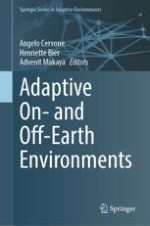2024 | OriginalPaper | Buchkapitel
5. Direct Ink Writing with Lunar Regolith: An Avenue for Off-Earth Construction
verfasst von : T. Schild, A. Cowley, B. Grundström, N. Garrivier, N. Hensch
Erschienen in: Adaptive On- and Off-Earth Environments
Aktivieren Sie unsere intelligente Suche, um passende Fachinhalte oder Patente zu finden.
Wählen Sie Textabschnitte aus um mit Künstlicher Intelligenz passenden Patente zu finden. powered by
Markieren Sie Textabschnitte, um KI-gestützt weitere passende Inhalte zu finden. powered by
Abstract
Long-term human and robotic exploration missions to the Moon, Mars and beyond, will require far higher levels of autonomy, flexibility and resilience than what is currently the case in low Earth orbit. Off-Earth manufacturing capabilities, especially ones using in situ resources, are an essential asset in this regard. They can indeed allow much more independence from Earth-based supplies and resources while enabling more audacious mission objectives. As also discussed in the chapter by Rich et al., additive manufacturing (AM) techniques are prime candidates for off-Earth applications. They allow a large variety of geometries to be produced using one single system, including complex 3D structures that cannot be achieved through conventional means. This makes them adaptable to evolving mission scenarios and unforeseen needs. In addition, they integrate readily with digital design techniques, supporting approaches such as computational design optimizations and generative design. Finally, AM allows a very efficient use of feedstock material by minimising the amount of scrap material. This is very beneficial in off-Earth scenarios where supplies are limited.
